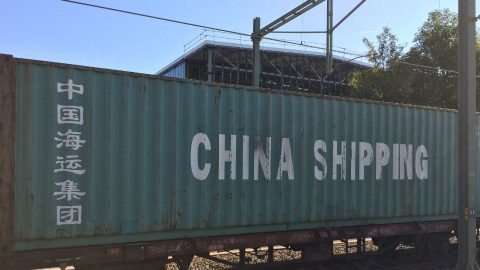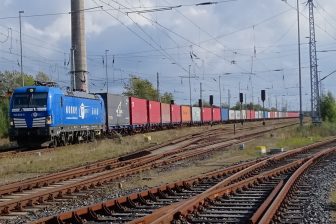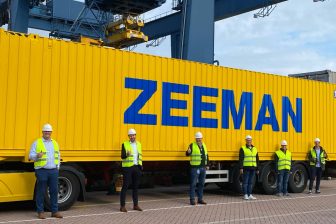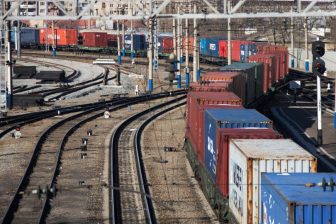
‘Railway transport Europe-China could be simplified’
The Chinese government has called for increased optimalisation of existing cooperation mechanisms when it comes to transport between Europe and China. International railway transport procedures should be simplified, transit costs lowered and goods should be better protected along the route. It made these remarks in the Third Policy Paper on the EU.
The year 2018 marks the 15th anniversary of the China-EU Comprehensive Strategic Partnership and the 20th anniversary of the China-EU Summit. The Chinese published a similar paper in 2003 and again in 2014. “Based on past achievements and in keeping with the times, China’s third policy paper on the EU aims at identifying the direction, principles and specific measures to deepen the China-EU Comprehensive Strategic Partnership in the new era and promote greater development of China-EU relations”, it wrote.
Belt and Road
The Chinese-European cooperation is specifically important for the rail industry within the context of the Belt and Road initiative, a Chinese development programme aiming to revive the transport network between the continents. The Chinese government invests heavily in, among others, the railway infrastructure en route, not limited to the Asian territories. In the meantime, the EU has its own perspective on the project, aiming for a mutual partnership, while ensuring that it is not in contradiction with EU’s interests and values.
“The EU has its own transport network policy – also known as the TEN-T Policy, where TEN-T stands for Trans-European Transport Networks. Our main goal is to promote its implementation in the EU, but also beyond, in particular in our neighbouring partner countries. It is of key importance, in this context, to exchange views on our respective plans and programmes to ensure that BRI will meet TEN-T”, Maja Bakran Marcich, Deputy Director-General of the Directorate-General for Mobility and Transport (DG MOVE) at the European Commission said earlier.
Active participation
“As an important global public good from China, the Belt and Road Initiative follows the principle of consultation and cooperation for shared benefits, upholds openness, inclusiveness and transparency, observes international rules and market principles, and pursues high quality and high standards tailored to local conditions.
China welcomes the active participation of the EU and other European countries in a joint effort to build a road that promotes peace, prosperity, openness and innovation, connects civilizations, facilitates green development, and upholds high ethical standards”, the Chinese policy paper reads.
Transparency
Inclusiveness and transparency have been a point of political debate between the world powers. “It is amazing to find that 89 per cent of Chinese-funded projects go to Chinese companies, leaving a mere 7 per cent to local contractors. When projects are funded through multilateral banks (World Bank, Asian Development Bank) the share of local contractors is above 40 per cent”, Marcich has said.
“China will significantly ease market access, fully implement the management system of pre-establishment national treatment and a negative list in a bid to foster a stable, fair, transparent, law-based and predictable business environment that protects the legitimate rights and interests of foreign investment and treats Chinese and foreign firms registered in China as equals.
“China hopes that the EU will keep its investment market open, reduce and eliminate investment hurdles and discriminatory barriers, and provide Chinese companies investing in Europe a fair, transparent and predictable policy environment and protect their legitimate rights and interests”, the paper reads.
Alignment
But according to the Chinese, there is more that can be done. Transportation cooperation mechanisms should be used at all levels, the government believes. Technical standards should be aligned, and customs procedures should be advanced to facilitate trade.
“The China-EU Joint Customs Cooperation Committee will provide better guidance and coordination for customs cooperation”, it wrote, naming among others border law enforcement, combating fraud, monitoring of solid waste, cross-border sanitary and phytosanitary quarantine, supervision of food safety, and actively exploring regulation of cross-border e-commerce.
Chinese import
“China will expand the import of high quality goods from the EU through existing channels and new platforms such as the China International Import Expo”, it also noted. Currently, westbound trade dominates Eurasian railway traffic, but Chinese import from the EU has started to pick up.
According to China, the EU could do more to encourage this type of trade. “The EU should ease its high-tech export control on China, strictly fulfill its WTO obligations, ensure that its trade remedy legislation and practices are in line with WTO rules, apply trade remedy measures reasonably, and prevent discrimination, de jure or de facto, against some WTO members.”
Eastern Europe
Although the official EU stance towards the Belt and Road initiative has been hesitant, Eastern European countries have been more active in cooperating with the Chinese government. “Based on common interests and needs, China and the Central and Eastern European countries have conducted win-win, open and transparent cross-regional cooperation. The support and constructive participation by the EU and other parties are welcomed”, the Chinese policy paper noted.
The EU Commission however stands critical towards these developments. We believe that the best way to tackle long-distance transport challenges is to develop an inclusive approach in a multilateral framework, like the EU-China Connectivity Platform, rather than to multiply bi-lateral cooperation agreements which might not always been well coordinated in terms of priority setting”, said Marcich commenting on the developments.
Platforms of cooperation
The cooperation between the powers is currently structured in various platforms, such as the the China-EU Connectivity Platform and the China-EU Joint Investment Fund. EU development plans could be more synergised with the Belt and Road initiative, believe the Chinese. Financial institutions like the Asian Infrastructure Investment Bank and the European Investment Bank could play a bigger role.
China remains committed to developing ties with EU institutions, member states and other European countries in a comprehensive, balanced and mutually reinforcing manner”, it wrote. It plans to fully leverage the role of the China-EU Summit, further implement the China-EU 2020 Strategic Agenda for Cooperation formulated in 2013 and discuss follow-up plans.





